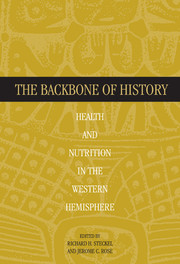Book contents
- Frontmatter
- Contents
- Preface
- List of Contributors
- PART I
- PART II METHODOLOGY
- PART III EURO-AMERICANS AND AFRICAN-AMERICANS IN NORTH AMERICA
- Introduction
- 5 The Health of the Middle Class: The St. Thomas' Anglican Church Cemetery Project
- 6 The Poor in the Mid-Nineteenth-Century Northeastern United States: Evidence from the Monroe County Almshouse, Rochester, New York
- 7 The Effects of Nineteenth-Century Military Service on Health
- 8 The Health of Slaves and Free Blacks in the East
- 9 The Quality of African-American Life in the Old Southwest near the Turn of the Twentieth Century
- PART IV NATIVE AMERICANS IN CENTRAL AMERICA
- PART V NATIVE AMERICANS AND EURO-AMERICANS IN SOUTH AMERICA
- PART VI NATIVE AMERICANS IN NORTH AMERICA
- PART VII
- PART VIII
- PART IX EPILOGUE
- Index
5 - The Health of the Middle Class: The St. Thomas' Anglican Church Cemetery Project
Published online by Cambridge University Press: 01 March 2010
- Frontmatter
- Contents
- Preface
- List of Contributors
- PART I
- PART II METHODOLOGY
- PART III EURO-AMERICANS AND AFRICAN-AMERICANS IN NORTH AMERICA
- Introduction
- 5 The Health of the Middle Class: The St. Thomas' Anglican Church Cemetery Project
- 6 The Poor in the Mid-Nineteenth-Century Northeastern United States: Evidence from the Monroe County Almshouse, Rochester, New York
- 7 The Effects of Nineteenth-Century Military Service on Health
- 8 The Health of Slaves and Free Blacks in the East
- 9 The Quality of African-American Life in the Old Southwest near the Turn of the Twentieth Century
- PART IV NATIVE AMERICANS IN CENTRAL AMERICA
- PART V NATIVE AMERICANS AND EURO-AMERICANS IN SOUTH AMERICA
- PART VI NATIVE AMERICANS IN NORTH AMERICA
- PART VII
- PART VIII
- PART IX EPILOGUE
- Index
Summary
ABSTRACT
The economic record establishes the midnineteenth century as a time of prosperity according to growth in incomes, wealth per capita, and technology. Less is known about the record on health, and that which is available suggests that improvements in the quality of life did not extend to mortality rates and morbidity levels. The population investigated here consists of almost 600 skeletons out of more than 1,500 individuals buried at St. Thomas' Anglican Church cemetery in Belleville, Ontario, between 1821 and 1874. Our investigations show that mortality rates, especially for infants, did not improve over the period of greatest cemetery use, from 1850 to 1874. Skeletal investigations support the interpretation of the importance of acute versus chronic infections and the significance of environmental conditions affecting infant morbidity and mortality. The skeletal variables identified as significant contributors to the quality of life index for St. Thomas' may fit with the conclusion that healthwise, life in the mid-nineteenth century was not measurably better for the middle to upper class at St. Thomas' and may coincidentally reflect a broader North American phenomenon related to urbanization. Nevertheless, these observations are also uniquely reflective of the church and town alone.
INTRODUCTION
Historians and other social scientists have been interested in the fate of various classes or socioeconomic groups during the transition from a settled agricultural to an urban-industrial way of life, a change that occurred in North America during the middle of the nineteenth century. The economic record clearly establishes the midnineteenth century as a time of prosperity according to growth in incomes, wealth per capita, and technology.
- Type
- Chapter
- Information
- The Backbone of HistoryHealth and Nutrition in the Western Hemisphere, pp. 130 - 161Publisher: Cambridge University PressPrint publication year: 2002
- 15
- Cited by



